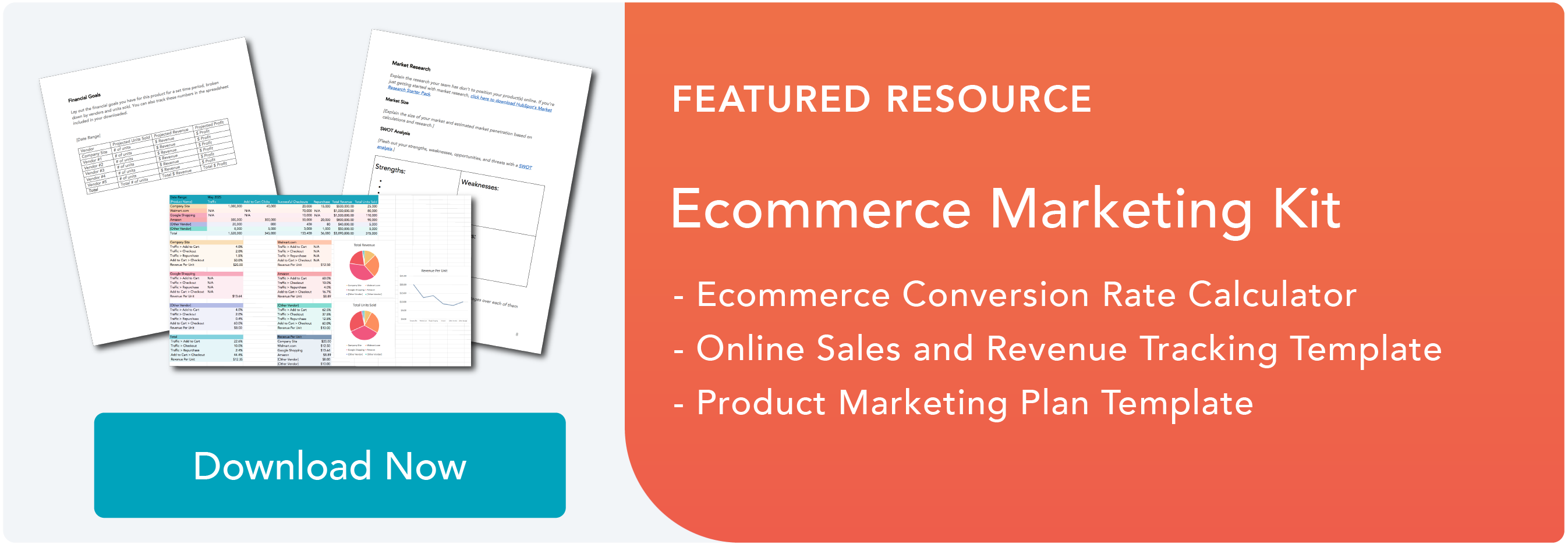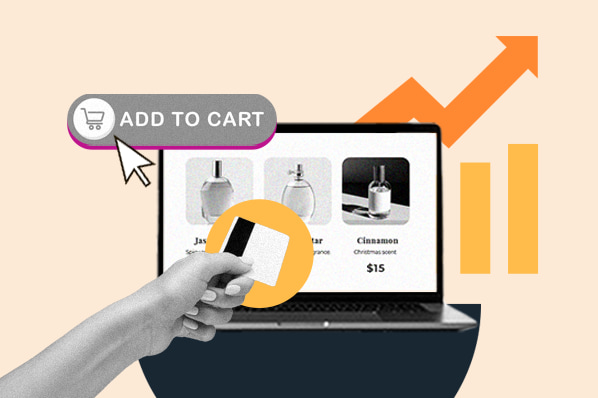In June 2021, over 440,000 businesses were launched, making it a record high since the start of the pandemic in March 2020.

Many are focusing on ecommerce businesses, as they offer an easier point of entry. There's no physical space to scope out, rent to pay, or permits to obtain. However, that doesn't mean starting an online business is a piece of cake.
Learn what it takes to start an ecommerce business and the steps to start one today.
What is an ecommerce business?
An ecommerce business is a company that sells goods and/or services exclusively online without a brick-and-mortar store.
Tips for Starting an Online Business
1. Design your website with intention.
Your website is your storefront – you don't want potential customers arriving, looking around, and walking right out.
Think of your website title and meta description as your window display. You want the description to be enticing enough to beat out the competition and get users to click on your website.
Your homepage is the first thing visitors see when they land (or walk in). What will you present to make them keep scrolling? Maybe it's your latest offer or a striking image from your latest campaign, or perhaps it's a simple but compelling CTA that will invite curiosity.
Users should be able to navigate your site seamlessly with little friction. That requires a lot of planning, designing, and iterating.
Just as you would take time to curate every section of your store, be sure to give that same care with your website. Every section should have a clear goal and lead users to your desired action.
A first impression can last and can be hard to change – so make sure it's a good one.
2. Don't skimp on your creative assets.
We've already mentioned the importance of designing your website with care and intention.
Now, let's get into the elements that will make up your website: your copy and visual elements, such as images and videos.
Your creative assets can make or break your brand perception. Don't believe me? Look at insurance company The General.
The company recently rebranded and revamped its entire marketing strategy because the public doubted the brand's credibility due to its perceived low-budget ads. They even addressed it in a commercial.
All this to say that it's vital that you invest in high-quality visuals as they will be a representation of your brand.
As for your copy, this is important to ensure every message you are putting out is driving the action you want. Otherwise, you may get visitors to your site but not get them to convert. If you don't feel equipped to take this on yourself, hire a copywriter who specializes in your industry.
For your visual assets, you can:
- Outsource the work to a marketing or branding agency, or work directly with professionals on a contract basis.
- Leverage sites like Pexels and Unsplash to get some high-quality stock product photos and videos that are free for commercial use.
- Use sites like Canva to create beautiful visuals that fit within your brand identity.
3. Social media will be key to your success.
Think of social media as a high-traffic area you want your store to be in.
Social media is one of the biggest discovery points for ecommerce brands, aside from search. If you post content where your audience lives online, you can help them discover your company and build a strong community of brand loyalists.
If you're doing it right, social media gets them interested in your brand, your website gets them to stick around and move to that next step in the buyer's journey.
4. Help customers help themselves.
Many ecommerce brands struggle with customer service.
They often have a small team that's unable to manage large volumes of requests from customers. One way to combat this is by offering helpful resources to current and prospective customers so they can the answers they need quickly.
After running your business for a while, you may notice that you get the same questions repeatedly. This is a clear sign that customers are experiencing friction on your site and need more support. FAQ and knowledge base pages are great ways to address that.
An FAQ section will not only be great for SEO, but also address your visitors' most pressing questions. A knowledge base will help your customers troubleshoot and solve their issues on their own.
This will also allow your team to focus on addressing more important issues instead of fielding simple requests.
5. Automate when and where you can.
On the topic of customer service, automation is the name of the game.
There are many ways to automate interactions in a way that leads them further down the buyer's journey. For instance, you could set up a chatbot that is designed to answer common questions from website visitors.
Automation can also look like:
- Email workflow after a customer makes a purchase to ask for a product/service review.
- Ticket creation for a member of your sales team to reach out to a prospect once they visit the pricing page.
- Unpublishing out-of-stock products and email notification sent to fulfillment team.
If you have a workflow in place, there's probably a way to automate it.
6. Leverage multi-channel selling.
As an ecommerce business, you want to maximize your reach and be everywhere your audience lives.
You may have some customers who shop directly from your store on your website. However, you may have some who shop exclusively on Amazon or Etsy.
To maximize your earning potential, sell your products on multiple marketplaces, as long as they align with your target audience and product.
How to Start Your Own Business Online
- Identify a gap in the market and validate your idea.
- Validate your idea.
- Develop your product and/or service.
- Name and file your business.
- Build your brand identity.
- Secure your domain and social handles.
- Choose an ecommerce platform.
- Develop a marketing strategy.
How to Start Your Own Business Online
1. Identify a gap in the market and validate your idea.
The best ideas stem from personal experience.
Maybe you experienced friction when completing a task and figured out a way to streamline it. Or perhaps you thought of a product that would make your life 10 times simpler.
Wherever the inspiration comes from, it's definitely worth exploring.
If you're having trouble coming up with an idea, try the SCAMPER method for brainstorming:
- Substitute – If there's an existing product/service you want to model yours after, perhaps you can substitute some elements to make it unique. Think vegan ice cream.
- Combine – You also have the option of combining two existing products to make one great one.
- Adapt – Have a product that you think needs some changes? See how you can adapt it to the times, the audience, or the location.
- Modify, Minify, or Magnify – This urges you to look at an existing product or service, and identify certain elements that could use some tweaking.
- Put to another use – Although something may have originally been used for one purpose, doesn't mean you can't repurpose it for something else. For instance, Misfits Market takes grocery items that are deemed too ugly for the stores and repurposes them by selling them directly to consumers.
- Eliminate – If you find a current product or process clunky and complex, perhaps you can develop a simpler way of doing things.
- Reserve/Rearrange – The way you present a product or idea can have a big impact on how it's perceived. This can be your entry into the market.
These options give you the freedom of developing something without the pressure of starting from scratch.
2. Validate your idea.
Once you identify a product or service, you have to validate it.
The hard truth is that not every idea is sustainable for a business. In this stage, you want to make sure that there's an audience for it and a need in the market.
How do you accomplish this? There are a few ways:
- Research – Resources like Google Trends can help you separate fads from trends that have longevity.
- Competitive analysis – Are there other companies currently offering the same or a similar product? How are they performing?
- Crowdfunding – Crowdfunding puts the power in the hands of the people by allowing them to fund ideas they believe in. This is a great way to confirm the need for your product but also get funds to jumpstart your business.
Your small business can get ahead of the highest ROI-producing eCommerce trends by keeping track of customer data. This year, voice search, sustainable packaging, and instant chat options are incredibly popular with customers, but that won’t always be the case. Keep checking your analytics software, so you can adjust when necessary.
3. Develop your product and/or service.
This stage is the one that may take the longest.
You'll need to figure out manufacturing, sourcing, packaging, shipping, pricing – all of the -ings.
The process you follow will all depend on your business type and industry. For instance, if you are developing a new product, that will involve a lot more steps than if you are white labeling (the process of purchasing products from a supplier and marketing it under your brand).
Need more help on this? Read this article on the product development process.
4. Name and file your business.
Once you have a clear understanding of your business and what it offers, you must come up with a name.
When it comes to naming your business, here are a few tips to keep in mind:
- Avoid names that can limit your business. Say I name my business "Martina Bretous Copywriting," it insinuates that I only offer copywriting as a service. Say I expand into marketing as a whole, I'll have to do more work to let my audience know.
- Make sure the name is not already trademarked or tied to a business in your same industry.
- Consider a name that's catchy and has a relevant meaning.
- Say your business name out loud to see how it sounds.
- Avoid names that are too general. E.g.: "Lux Clothing"
- If you're debating between a few options, see if the domains and social media handles are available. That can help you narrow down the best choice for you.
After submitting your business name to your state department, you'll also want to apply for an employee identification number (EIN) for tax purposes.
Lastly, do you need any permits and licenses to operate? Be sure to speak with a professional about the rules and regulations in your state and submit proper documentation before launching your business.
5. Build your brand identity.
Now that the legal details are all covered, you can get to the fun part: Building your brand.
This step is key as it will influence how you market your brand to your target audience. In this step, you'll need to ask yourself a few questions:
- What is our mission?
- What do we stand for?
- If this brand was a person, how would we describe them?
- How do we want to be perceived in the market?
From there, you can start working on your brand logo, colors, tone, and other creative assets that reflect your identity.
6. Secure your domain and social media handles.
Developing a strong online presence will be instrumental to the success of your ecommerce business. As such, you want to start early.
It's easy to find and buy a domain online. Top domain sites include:
Many site builders, like Squarespace and Wix, and most hosting platforms also allow you to buy your domains directly from them. That way, the site that owns your domain will be the same one where you host your ecommerce site.
7. Choose an ecommerce platform.
The internet is full of ecommerce platforms, each offering different features and benefits.
To start, determine the level of customization you want. There are four categories of ecommerce platforms you can choose from:
- Strictly ecommerce platforms that offer tiered packages based on your needs. Think Shopify, BigCommerce, and Shift4Shop.
- Website builders with templates and ecommerce tools like Square, Wix, Squarespace that can be used to build any site but offer features like product catalog management, shipping tools, abandoned cart recovery.
- Ecommerce WordPress plugins, like WooCommerce, that are ideal for people who already use the CMS and are familiar with its platform, and want to build from it.
To decide, look at what your timeline and what you want to accomplish. Pre-built websites make it easy to build an ecommerce site quickly. However, they're not very customizable and can be limiting.
On the flip side, there are fully customizable platforms that offer a lot but can take much longer to set up.
Top features to look for in an ecommerce platform include:
- Product and order management
- Mobile compatibility
- Reporting and analytics
- Built-in SEO capabilities
- Abandoned cart recovery
- Third-party system integrations
- Advanced content management system
- Multi-channel sales
8. Develop a marketing strategy.
The last step before launching your business is developing a pre- and post-launch strategy.
The idea behind a pre-launch strategy is to get your target audience excited about your product or service before it's available. If done right, you'll have a line of customers waiting to try out your products.
A post-launch strategy is a more long-term marketing strategy that involves tying your business objectives to specific marketing goals, such as building brand awareness and acquiring more leads.
Your marketing strategy should also account for audiences at all stages of the buyer's journey. If you focus too much on the top of the funnel, you won't be able to convert leads into customers. If you focus on the bottom of the funnel, you won't be able to attract new customers to your business.
In 2022, building an ecommerce business is more accessible than it's ever been. If you follow the steps outlined above, you'll have your company up and running in no time.


![How to Write an Ecommerce Business Plan [Examples & Template]](https://blog.hubspot.com/hubfs/ecommerce%20business%20plan.png)




![How to Send Effective Order Confirmation Emails [Examples + Template]](https://blog.hubspot.com/hubfs/order-confirmation-email-1.jpg)


